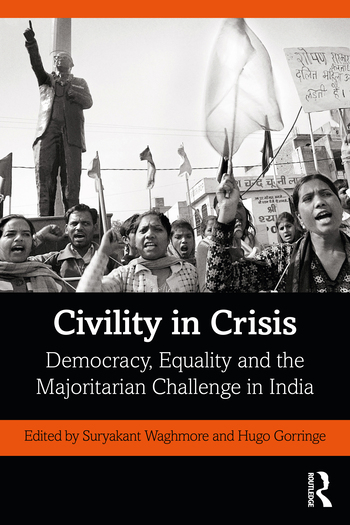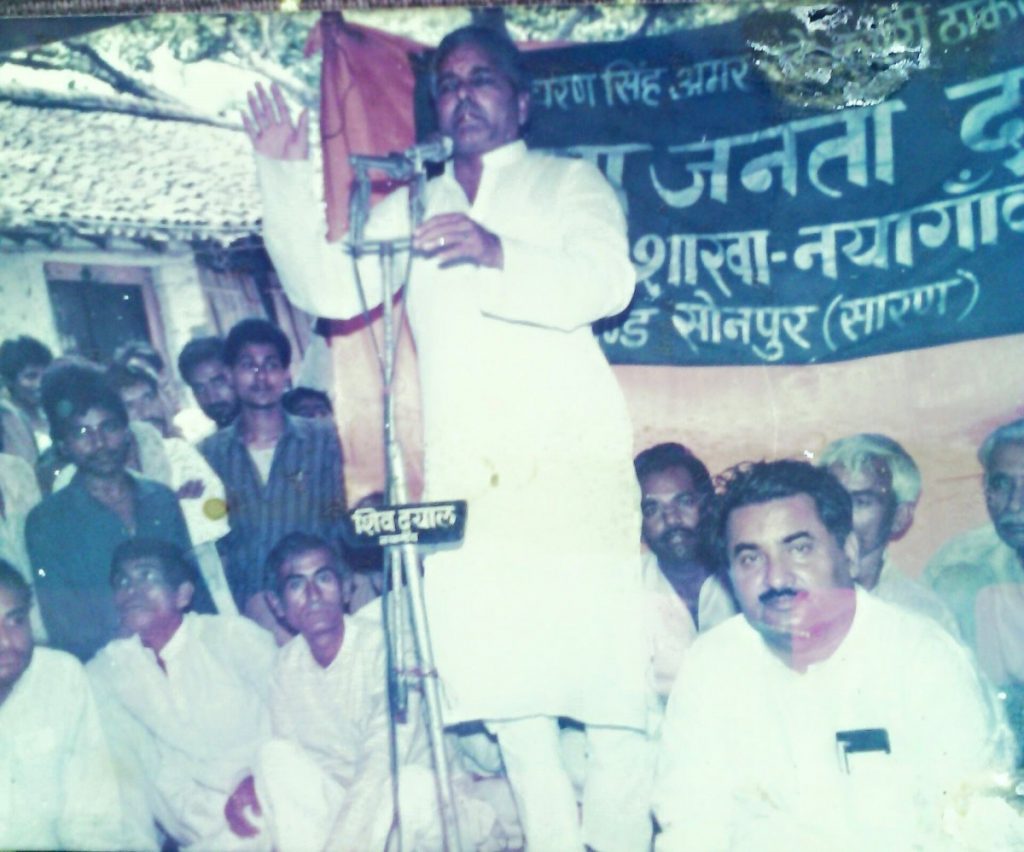Dignifying Democracy in Bihar: Lalu Prasad Yadav, Social Justice and Equality
The ongoing electoral campaign in Bihar has seen three-term Chief Minister Nitish Kumar needing to remind his audiences about the alleged “jungle raj” of his predecessor Lalu Prasad Yadav. In a chapter for a forthcoming book titled Civility in Crisis: Democracy, Equality and the Majoritarian Challenge in India edited by Professors Suryakant Waghmore and Hugo Gorringe, I argue that Yadav’s rule has to be carefully examined for the feelings of dignity he evoked among the Bahujan majority in the state, who account for nearly 80% of its population.
A new political vocabulary
Yadav’s ascendance to power in 1990 deepened the political vocabulary of social justice and equality. A key message that Yadav and his Janata Dal government highlighted throughout their tenure was the paramountcy of people’s sense of “dignity” (ijjat). In emphasising the importance of dignity, Yadav provided institutional support to popular struggles for equality in the state.
Specific policy interventions included: the elimination of tree and toddy tax; regularisation of slums; and allowing milk suppliers to establish cowsheds freely in towns and cities. Bihar University was renamed as B.R. Ambedkar University after India’s foremost champion of civil rights. State holidays were declared to mark the birth anniversaries of Ravi Das, a sixteenth century saint who remained a fervent champion of social equality in his lifetime. Yadav’s government extended official support to fairs commemorating the Dalit hero Chuharmal credited with battling dominant caste oppression. In line with the Janata Dal’s promise of greater representation for the state’s communities in public life, 50% seats were ‘reserved’ for OBCs in university-level decision-making bodies.

Civility in Crisis Democracy, Equality and the Majoritarian Challenge in India
Ed. Suryakant Waghmore and Hugo Gorringe
Routledge India (December 2020)
Complementing these policy interventions were political strategies aimed at ‘lower’ caste empowerment. One, the Janata Dal politicised the rural poor by convening public rallies through which they developed shared solidarities cutting across caste distinctions. Jeffrey Witsoe tells us of awareness rallies organised by the state government during the Yadav years in which peasants and the rural poor would be invited to travel to and demonstrate their collective presence in the heart of Patna, creating moral panic among the city’s gentry. Two, Yadav developed personalised networks with politicians and political mediators, not on the basis of their caste but on their ability to deliver him votes. His cronies included Rajputs and Bhumihars, who styled themselves as ritually superior to Lalu’s Yadav community. The image of superior-caste Rajput and Bhumihar leaders supplicating before Lalu Yadav thrilled the Chief Minister’s rural constituency, symbolising to them an inversion of the conventional idioms of the paternalism to which they had been subjected during the colonial and Congress regimes. Three, Yadav’s government systematically emasculated the state bureaucracy as well as the police dominated by the privileged castes. His Janata Dal government famously reined in the police when landless labourers sought to occupy agricultural properties illegally held by the landlords, imbuing among the rural poor, especially the historically oppressed Dalit and OBC populations, a sense of dignity.
Caste antagonism?
From its inception, Yadav’s Janata Dal government faced accusations of fomenting caste antagonism in the state. The travel writer William Dalrymple recalls one of Yadav’s election speeches during his campaign against the Congress, replete with the imagery of ‘conflict’:
Our fight is against the wearers of the sacred thread. For centuries, the priests have made fortunes looting peasants. Now I tell them they should learn to milk cattle and graze them, otherwise they will starve.
Commentators appear to be particularly struck by the fact that, under Lalu Yadav’s tenure, ‘lower caste’ and ‘untouchable’ agricultural labourers became emboldened in their claims for fair wages and respect from their dominant caste landlords. They were also less willing to quietly acquiesce in their own exploitation and discrimination. They were more willing and able to retaliate against dominant caste mistreatment of their persons and properties. The result was an intensification of Bihar’s infamous caste wars, with Backward Castes and Dalits retaliating against violence perpetrated by dominant caste militias. For example, in December 1991, members of a dominant caste outfit that went by the name Savarna Liberation Front were alleged to have gangraped and murdered ten Dalit women. In February 1992, alleged left-wing militants, all either Dalit or Backward Caste, supposedly massacred thirty-five dominant caste landlords in retribution. Yadav leaders of the Janata Dal were blamed for fuelling antipathy among the subaltern population against the dominant castes: the Chief Minister’s speeches on social justice were held responsible for the massacre.
Chronicling his travels in rural Bihar at the turn of the millennium, Dalrymple narrates his exchange with a dominant caste landowner who survived the massacre. Describing his travails, Darlymple’s interlocutor confidently declares that this massacre was the handiwork of the Bihar government, singling Lalu Prasad Yadav for blame:
The government will not protect us. It is on their side. This is the Kali Yug, the epoch of disintegration. The lower castes are rising up. Everything is falling apart.
As far as Bihar’s landowning dominant castes could see, the advent of Lalu Yadav was nothing short of a disaster.
Also Read: Mood in Nitish Kumar's Stronghold Could Explain His Focus on Lalu Prasad's Rule
Dignity
These perspectives were somewhat echoed by subaltern populations, including Dalits who otherwise had little love lost for either Lalu Yadav or the Yadav community. In the north Bihar regions where I conducted fieldwork for my book Politics of the poor: Negotiating democracy in contemporary India during 2009 and 2010, a few years after Lalu Yadav was routed in the elections, my interlocutors from the Musahar community – historically stigmatised as ‘rat-eaters’ recalled his early years with a glimmer in their eyes. “Lalu helped us find our voice”, they said. Some among them told me of the lands they occupied under the aegis of the Janata Dal’s earliest years. “The man did little to help. But, unlike the Congressmen, he did not come in the way when we fought for our dignity”.
Indeed, my fieldwork notes are replete with references to terms such as ijjat. Accounts of labourers not giving ijjat to farmers, of people stigmatised as ‘low castes’ demanding to be treated with ijjat by self-styled ‘high castes’, of people wanting to lead lives with ijjat were strewn across my field notes. Ijjat is of course a notoriously slippery term: it could mean dignity in an emancipatory sense, referring to the shared dignity of all human beings. But it could also refer to honour, which could assume supremacist undertones, such as intimated by “honour killings”. The ijjat to which my interlocutors were referring, appears to possess an ethical quality. Unlike the concept of honour, which has to be earned, the ways in which the term ijjat was invoked suggests that dignity belongs to all, but is only recognised by some. It is the lack of recognition by some which claims of dignity challenge: ijjat is about recognition as equal members of society by other members of society. To be sure, claims of ijjat need not transcend caste identities. Indeed, such claims may well be advanced to demand that all castes must be accorded equal ijjat and/or that members of each caste be treated as all others are. Even as ‘caste’ remains important to public life, the deployment of ijjat has contributed to definitively challenging the supremacist assumptions held by members of the Savarna castes.
Such challenges are enmeshed in idioms of conflict as is frequently invoked through contentions between ‘Backwards’ and ‘Forwards’, frequently used in Bihar. Such conflict was a key theme during the campaign for the 2015 Vidhan Sabha elections in the state. Yadav famously dared the chief of the Rashtriya Swayamsevak Sangh, the ideological fount of the Bharatiya Janata Party, to scrap the provisions for ‘reservations’ of jobs for Scheduled Castes, Scheduled Tribes and Other Backward Classes as the latter had suggested. Yadav toured the state throughout the campaign period with a copy of the Bunch of Thoughts, a book written by RSS ideologue M.S. Golwalkar and regularly read out passages to highlight his caste supremacist views and the need to frontally assault them. Rarely in Indian elections has a book been the basis of electoral contests as it was in the autumn of 2015, when Yadav, at the helm of the Grand Alliance comprising the rival Janata Dal parties and the Congress Party, declared that the election was a ladai between the ‘Backwards’ and ‘Forwards’.

Lalu Prasad Yadav in 1988. Photo: Gailatu/Wikimedia Commons CC BY SA 4.0
Agonistic, not antagonistic, conflict
However, while the vocabularies of dignity are embedded in idioms of conflict between the ‘Backwards’ and ‘Forwards’, they are rarely invoked as a call to armed violence. Although caste violence remained a feature of public life in Bihar till the very end of the Janata Dal’s tenure in 2004, and the militias are unlikely to have been able to sustain themselves without political patronage from the state’s various political parties, Yadav carefully refrained from either calling for or condoning violence against the privileged classes or dominant castes.
Bihar’s so-called 'jungle raj' under Yadav illustrates a key concern of democracy that involves conflicts over what is just and fair. As the political philosopher Chantal Mouffe urges us in her pithy little book The Democratic Paradox, it is impossible to eliminate conflict from democratic life, especially in hierarchical and inegalitarian contexts. She alerts us that, even in contexts of free and fair elections where robust mechanisms exist to hold elected leaders accountable, the dimension of conflict can neither be wished away nor coopted within electoral institutions. Instead, Mouffe offers us what she calls ‘an agonistic account’ to conceptualise democratic processes as spaces which supply an arena for reconfiguring power relations. Proponents of the agonistic view distinguish themselves from votaries of antagonistic conflict. Antagonism is violent and involves physical liquidation of adversaries. By contrast, the perspective of agonism points us to negotiations over the terms on which the political community is constituted. The protagonists of an agonistic relation, even as they are in conflict, see themselves as sharing a common symbolic framework. The protagonists do not seek to liquidate one another. Rather, their politics seeks to reconfigure power relations towards a fairer and more just society. Yadav’s politics of dignity allowed the state’s historically oppressed people to challenge the power relations that had repressed them for centuries.
Like any politician, Yadav had weaknesses. Dignifying democracy by popularising a vocabulary of social justice and equality was not one of them.
Indrajit Roy is Sr. Lecturer, Global Development Politics, Universty of York
This article went live on October twenty-second, two thousand twenty, at thirty minutes past ten in the morning.The Wire is now on WhatsApp. Follow our channel for sharp analysis and opinions on the latest developments.





